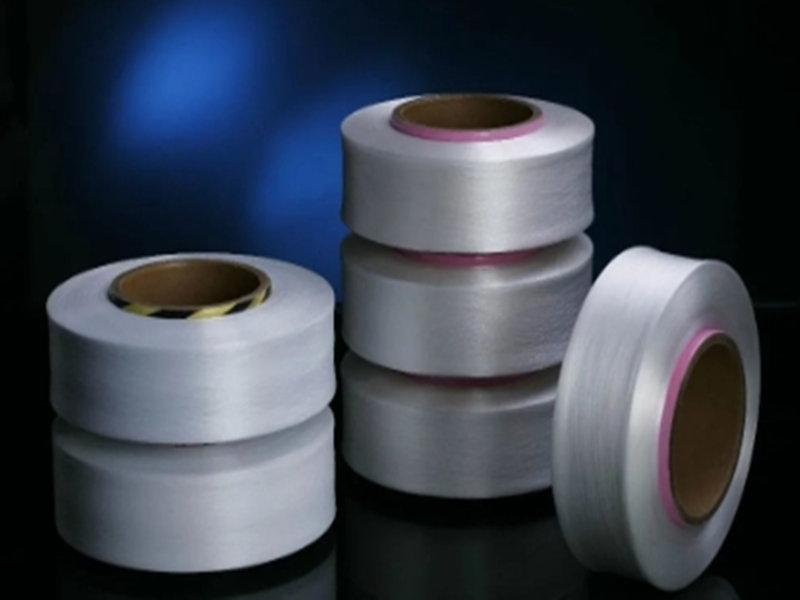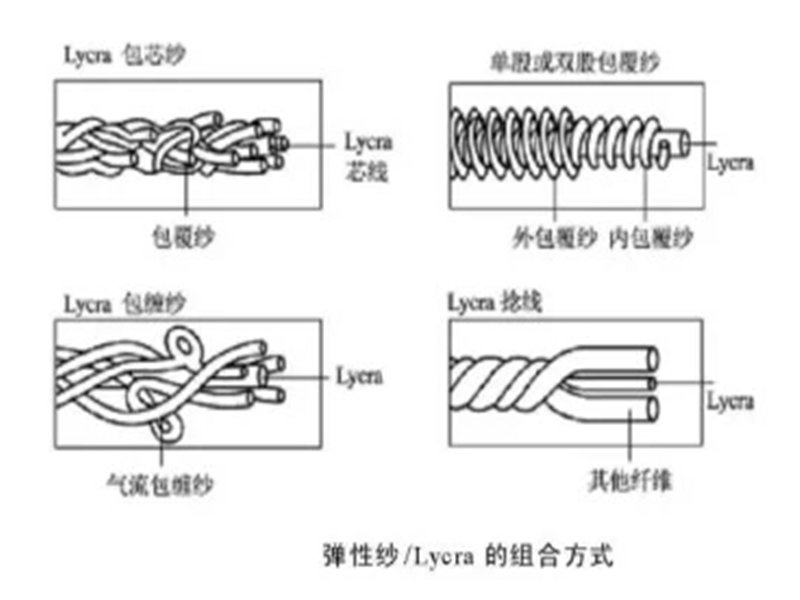Spandex, scientific name is polyurethane fiber, English name spandex, abbreviation PU.
In 1937, the German Bayer Company successfully developed it; in 1959, the American DuPont Company began industrial production; in 1989, China's first spandex production factory, the Yantai Spandex Factory, was put into operation. Now, China has become the world's largest producer of spandex.

Spandex usually exists in four forms in textiles: bare yarn, core-spun yarn, covered yarn, and twisted yarn.
1. Spandex bare yarn:
The earliest developed polyurethane elastic fiber variety has good stretch and recovery properties and can be produced without spinning processing, so it has the advantage of low cost. Due to the large friction coefficient and poor sliding properties of bare yarn, it is rarely used directly for weaving fabrics. It is generally suitable for interweaving with other chemical fiber filaments on knitting machines. The main textile products include tights, sportswear, leggings, surgical bandages, stocking cuffs, cuffs, etc.
2. Core-spun yarn
Core-spun yarn uses spandex yarn as the core and is wrapped with one or several non-elastic short fibers. Yarns with natural fibers as the wrapped fibers have good hygroscopicity. And because of this coating, the core yarn is generally stretched when stretched. It is also not exposed, so it is very comfortable, and dark-dyed products will not affect the same color due to the light spandex color. However, the strength of core-spun yarn is relatively low. Generally, the strength of a single yarn is only equivalent to 80% to 90% of that of the same specification of outer fiber yarn alone.
A yarn spun with polyurethane elastic fiber as the core yarn and one or several non-strong short fibers (cotton fiber, wool, polyacrylonitrile fiber, polyester fiber, etc.) wrapped around it. The core layer provides excellent elasticity and the peripheral fibers provide the required surface characteristics. For example: cotton core-spun yarn, in addition to good elasticity, also maintains the feel and appearance of ordinary cotton yarn. Its fabric has the style, feel and performance of cotton cloth, and can be made into a variety of cotton-type fabrics; wool core-spun yarn clothing fabrics not only It has the appearance and good warmth retention of ordinary wool fabrics, and the fabric has good resilience and can stretch freely when worn, which enhances comfort and can show a beautiful body shape. Compared with other elastic yarns, core-spun yarn has a significant feature, that is, the core yarn is not easily exposed when the yarn is stretched tightly, so the dyeing effect is good, and it is suitable for products of various colors including dark colors. But its strength is lower than other stretch yarns. Core-spun yarn is the most widely used yarn variety among polyurethane elastic fibers.
3. Covered yarn
The covered yarn feels stiffer, the yarn is thicker, and the woven fabric is thicker. The strength of the covered yarn is the strength of the outer covering filament or yarn, so it is higher than the strength of the core-spun yarn of the same specification. Covered yarn can be divided into single covered yarn and double covered yarn.
Covered yarn is also an elastic yarn formed by using spandex as the core and inelastic filament or short fiber yarn covering the elongated spandex yarn in a spiral manner. One of the most obvious differences between covered yarn and other elastic yarns is that the core yarn has no twist. The degree of cohesion between the core yarn and the outer covering is significantly lower than that of core yarn and twisted yarn, so its elasticity is higher than the latter two. Therefore There is core exposure in the tensioned state. If there is a significant color difference between the dyeing depth of the spandex yarn and the outer fiber, the same color of the textile will be reduced under tension, which is more obvious for dark-colored products. The strength of the covered yarn is mainly the strength of the outer filament or yarn, so the strength is relatively high.
4. Twisted yarn
Also known as plied yarn, it is formed by combining and twisting two other inelastic yarns while drawing the polyurethane elastic fiber. If this kind of yarn is untwisted, the tension will be weakened and a lighter impact will be applied to the entire yarn, so that the relative movement between the yarns will reach a stable state, and finally the elastic fibers will enter the yarn core and other inelastic yarns will It becomes the outer layer and the twisted yarn structure is stabilized. This method can be used to produce various fancy twisted yarns or three-in-one twisted yarns. Twisted yarn is mostly used to weave thick fabrics, such as elastic denim, elastic single-sided gabardine, etc. The advantage is that the dryness is even and the product is clean; the disadvantage is that it feels slightly hard and some elastic fibers are exposed, which makes it easy to cause color difference during dyeing, so it is generally not used for dark-colored fabrics.
Twisted yarn, also known as plied yarn, is made by stretching spandex and twisting it together with two other inelastic yarns. Spandex yarn can be used with various yarns or filaments to produce elastic twisted yarn. Since the spandex yarn and other yarns are twisted with each other, the spandex yarn will be exposed when the yarn is in tension. If the color of spandex is very different from that of other twisted threads during dyeing, the textile will have poor same-color properties and is not suitable for dyeing dark colors. The strength of the twisted yarn is equal to the elasticity of the matching non-elastic yarn, so the strength is higher. The degree of cohesion between spandex yarn and non-elastic yarn is also lower than that of core-spun yarn, so its elasticity is also higher than that of core-spun yarn.

Tags :